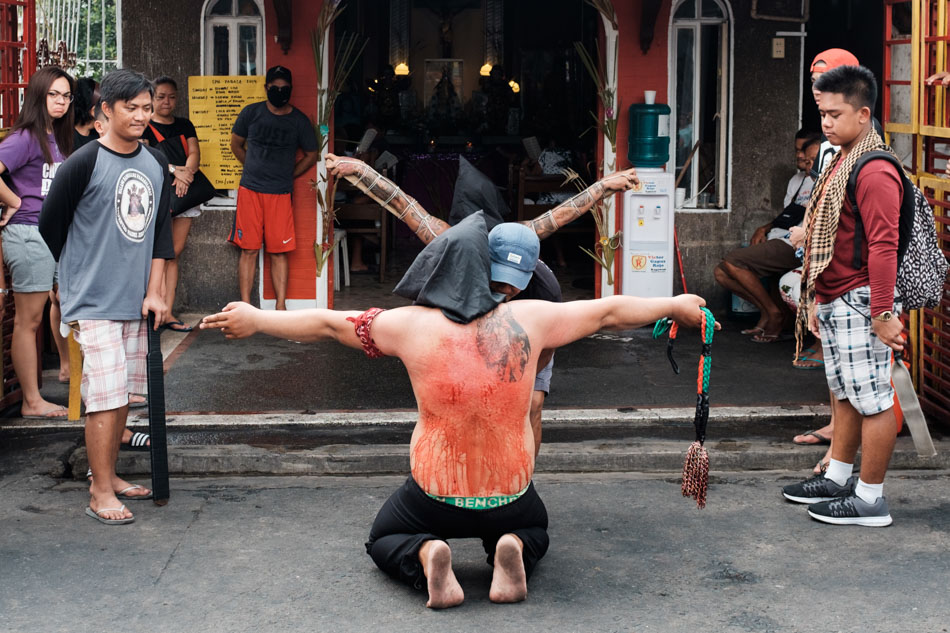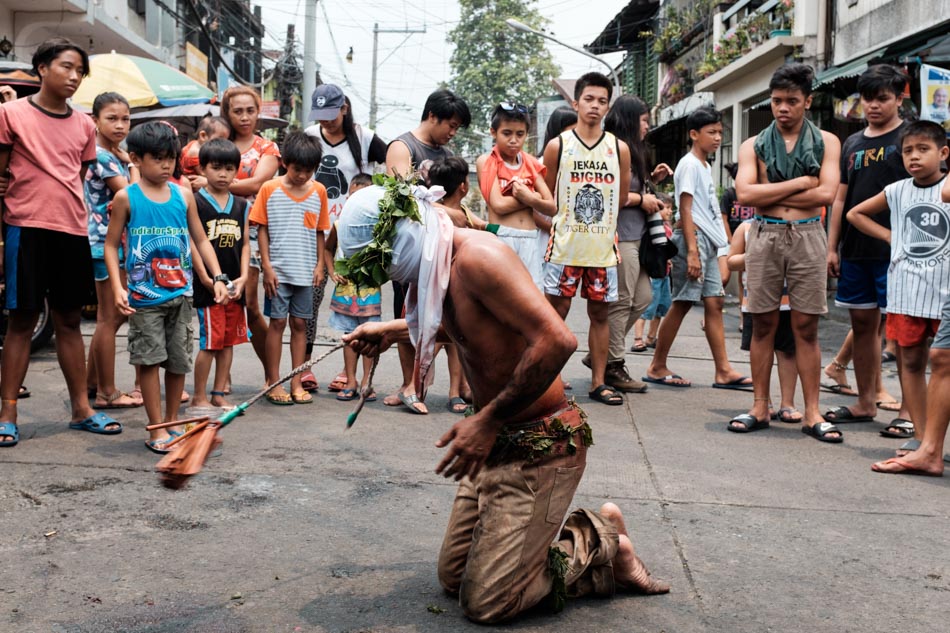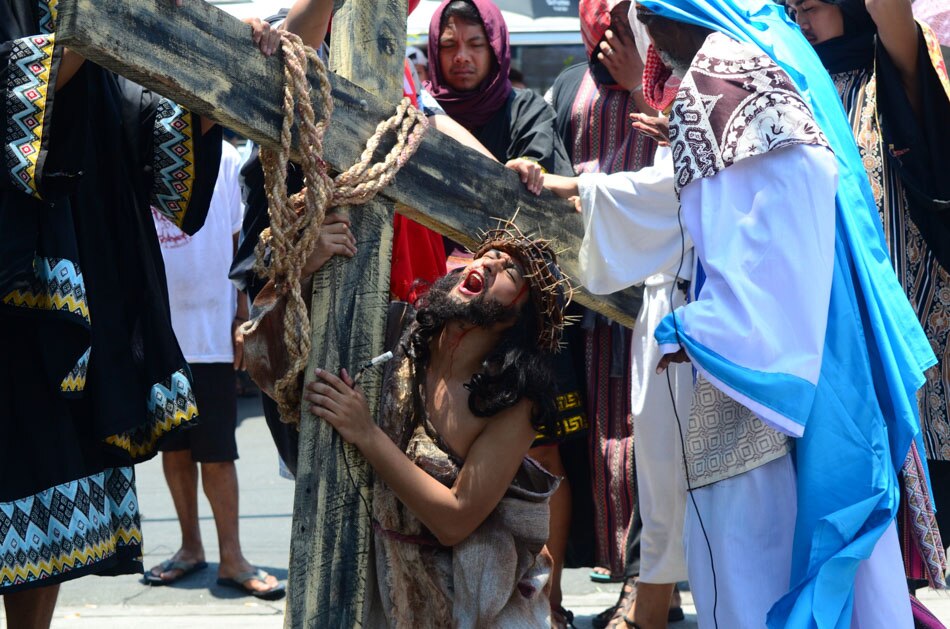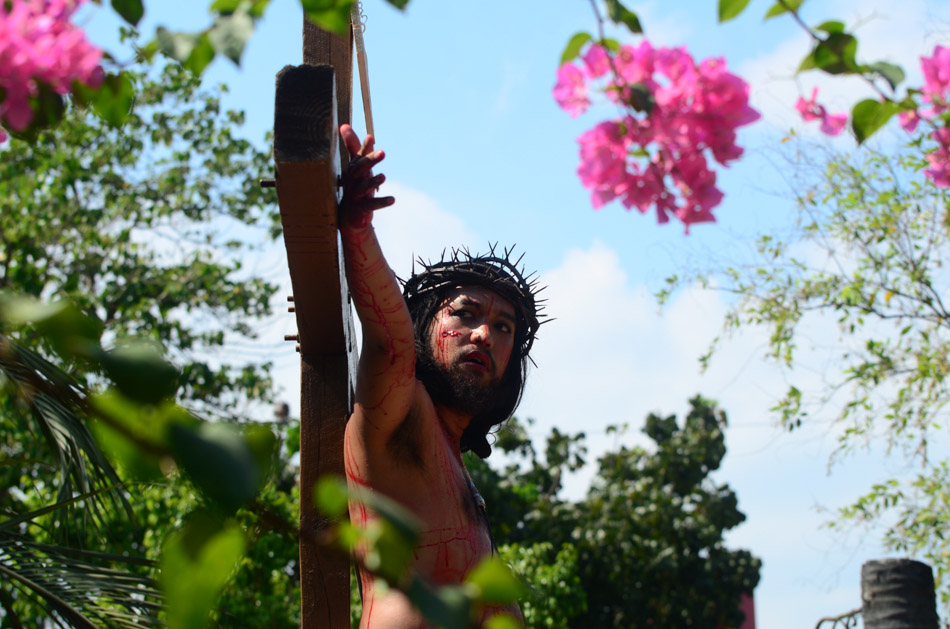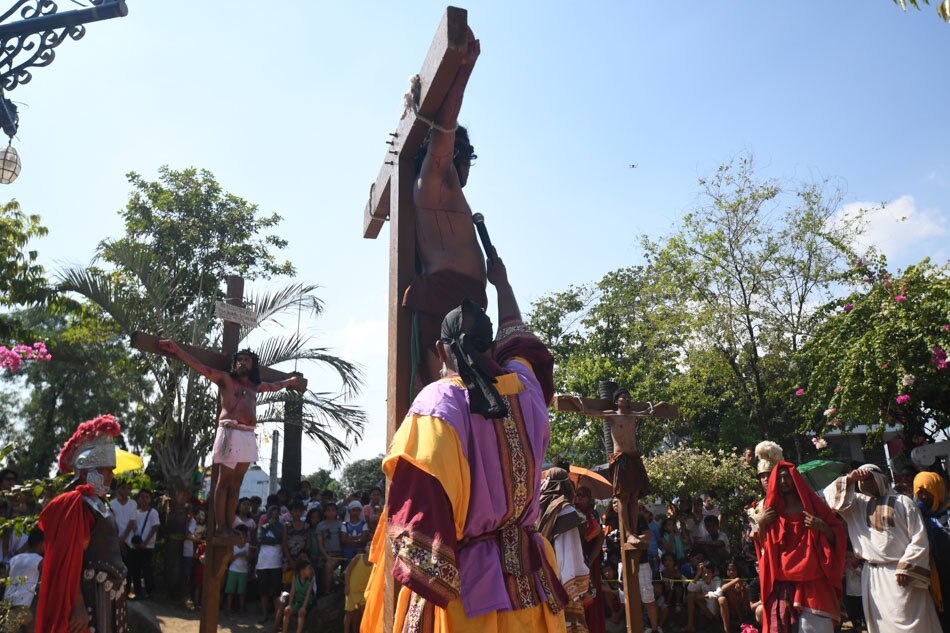Extreme Easter: Flogging, crucifixions mark Lent in the Philippines | ABS-CBN
ADVERTISEMENT

Welcome, Kapamilya! We use cookies to improve your browsing experience. Continuing to use this site means you agree to our use of cookies. Tell me more!
Extreme Easter: Flogging, crucifixions mark Lent in the Philippines
Extreme Easter: Flogging, crucifixions mark Lent in the Philippines
Ron Lopez,
Agence France-Presse
Published Apr 19, 2019 04:01 PM PHT
|
Updated Apr 19, 2019 05:09 PM PHT
MANILA (UPDATE)- A man was nailed to a cross with up to 10 more to follow while barefoot men beat themselves with flails on Good Friday, in a blood-soaked display of religious fervor in the Philippines.
MANILA (UPDATE)- A man was nailed to a cross with up to 10 more to follow while barefoot men beat themselves with flails on Good Friday, in a blood-soaked display of religious fervor in the Philippines.
Frowned upon by the Church, the ritual crucifixions and self-flagellation in the north of the country are extreme affirmations of faith performed every Easter in Asia's Catholic outpost.
Frowned upon by the Church, the ritual crucifixions and self-flagellation in the north of the country are extreme affirmations of faith performed every Easter in Asia's Catholic outpost.
Wilfredo Salvador stared at the sky and appeared to mumble a prayer after the slight 62-year-old with wild grey hair and a long beard became the first local zealot this year to hang from a wooden cross.
Wilfredo Salvador stared at the sky and appeared to mumble a prayer after the slight 62-year-old with wild grey hair and a long beard became the first local zealot this year to hang from a wooden cross.
"I will not stop this for as long as I am alive, because this is what gives me life," said Salvador, a fisherman who has been volunteering to be crucified for 14 straight years since recovering from a nervous breakdown.
"I will not stop this for as long as I am alive, because this is what gives me life," said Salvador, a fisherman who has been volunteering to be crucified for 14 straight years since recovering from a nervous breakdown.
ADVERTISEMENT
Assistants costumed as Roman centurions drove eight-centimeter (three-inch) spikes through each of his hands and feet before the wooden cross was raised briefly for the crowds to see.
Assistants costumed as Roman centurions drove eight-centimeter (three-inch) spikes through each of his hands and feet before the wooden cross was raised briefly for the crowds to see.
He was treated and bandaged at a first aid tent after the village square ritual -- then nonchalantly walked back home.
He was treated and bandaged at a first aid tent after the village square ritual -- then nonchalantly walked back home.
Nine other men and a woman were set to be nailed to wooden crosses in three other villages in the region within the day, the local tourism office told reporters.
Nine other men and a woman were set to be nailed to wooden crosses in three other villages in the region within the day, the local tourism office told reporters.
Earlier Friday, hundreds of barefoot men wearing crowns of twigs and black shrouds walked silently on the side of a village road in the scorching tropical heat, flogging their backs with bamboo strips tied to a length of rope.
Earlier Friday, hundreds of barefoot men wearing crowns of twigs and black shrouds walked silently on the side of a village road in the scorching tropical heat, flogging their backs with bamboo strips tied to a length of rope.
While many of the 80 million Filipino Catholics spend Good Friday at church or with family, others go to these extreme lengths to atone for sins or seek divine intervention in a spectacle that has become a major tourist attraction.
While many of the 80 million Filipino Catholics spend Good Friday at church or with family, others go to these extreme lengths to atone for sins or seek divine intervention in a spectacle that has become a major tourist attraction.
ADVERTISEMENT
"This is a religious vow. I will do this every year for as long as I am able," 38-year-old truck driver Resty David, who has been self-flagellating for half his life, told AFP.
"This is a religious vow. I will do this every year for as long as I am able," 38-year-old truck driver Resty David, who has been self-flagellating for half his life, told AFP.
He said he also hoped it would convince God to cure his cancer-stricken brother.
He said he also hoped it would convince God to cure his cancer-stricken brother.
Blood and sweat soaked through the penitents' pants with some spectators grimacing with each strike of the lash.
Blood and sweat soaked through the penitents' pants with some spectators grimacing with each strike of the lash.
Some hid behind their companions to avoid the splatter of gore and ripped flesh.
Some hid behind their companions to avoid the splatter of gore and ripped flesh.
Many in the crowds had driven for hours to witness the crucifixions -- the frenzied climax of the day's gory spectacle that Catholics say is a re-enactment the crucifixion of Jesus Christ.
Many in the crowds had driven for hours to witness the crucifixions -- the frenzied climax of the day's gory spectacle that Catholics say is a re-enactment the crucifixion of Jesus Christ.
ADVERTISEMENT
German tourist Annika Ehlers, 24, was among them.
German tourist Annika Ehlers, 24, was among them.
"I'm a little bit overwhelmed. It's very intense, I haven't expected something like this," she told AFP after watching Salvador's crucifixion.
"I'm a little bit overwhelmed. It's very intense, I haven't expected something like this," she told AFP after watching Salvador's crucifixion.
The bloody spectacle has played out every year in villages around the city of San Fernando, about 70 kilometers (40 miles) north of Manila, despite Church entreaties to spend Lent in quiet prayer and reflection.
The bloody spectacle has played out every year in villages around the city of San Fernando, about 70 kilometers (40 miles) north of Manila, despite Church entreaties to spend Lent in quiet prayer and reflection.
"The crucifixion and death of Jesus are more than enough to redeem humanity from the effects of sins. They are once in a lifetime events that need not be repeated," Catholic Bishops' Conference of the Philippines official Father Jerome Secillano said.
"The crucifixion and death of Jesus are more than enough to redeem humanity from the effects of sins. They are once in a lifetime events that need not be repeated," Catholic Bishops' Conference of the Philippines official Father Jerome Secillano said.
"Holy Week... is not the time to showcase man's propensity for entertainment and Pharisaical tendencies," he added.
"Holy Week... is not the time to showcase man's propensity for entertainment and Pharisaical tendencies," he added.
ADVERTISEMENT
'PRAYER AND REFLECTION'
President Rodrigo Duterte, meanwhile, called on Filipinos to be inspired and renew their obligation in serving people as they commemorate Lent.
President Rodrigo Duterte, meanwhile, called on Filipinos to be inspired and renew their obligation in serving people as they commemorate Lent.
In his Holy Week message, Duterte acknowledged that Filipinos' strong faith in God has helped the nation become more resilient.
In his Holy Week message, Duterte acknowledged that Filipinos' strong faith in God has helped the nation become more resilient.
"May this blessed occasion be an opportunity for prayer and reflection as we strive to uphold what is good and just. Let the spirit of this commemoration inspire us to rekindle our commitment to serve our people, especially those who are in most in need," said Duterte in a statement.
"May this blessed occasion be an opportunity for prayer and reflection as we strive to uphold what is good and just. Let the spirit of this commemoration inspire us to rekindle our commitment to serve our people, especially those who are in most in need," said Duterte in a statement.
Duterte said he was hoping that virtues of faith, hope and charity will continue to drive efforts in nation-building.
Duterte said he was hoping that virtues of faith, hope and charity will continue to drive efforts in nation-building.
"With guidance from Christ's sacrifice, let us work towards the attainment of our noble aspirations for the nation," he said.
"With guidance from Christ's sacrifice, let us work towards the attainment of our noble aspirations for the nation," he said.
ADVERTISEMENT
Nearly 80 percent of people in the Philippines are Catholic, a legacy of the nation's 300 years of Spanish colonial rule that ended at the turn of the 20th century.
Nearly 80 percent of people in the Philippines are Catholic, a legacy of the nation's 300 years of Spanish colonial rule that ended at the turn of the 20th century.
ADVERTISEMENT
ADVERTISEMENT



